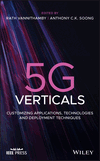Effects of Dynamic Blockage in Multi-Connectivity Millimeter-Wave Radio Access
Summary
This chapter outlines the methods to capture and characterize the blockage effects in cellular millimeter-wave (mmWave) systems together with the state-of-the-art techniques to mitigate the negative effects of dynamic blockage on both user- and network-centric performance indicators. It first discusses the key aspects of mmWave signal blockage by various objects in urban deployments and its consecutive impact on link-level performance. Further, the chapter summarizes mathematical methods to model the dynamic blockage processes in different Internet-of-Things (IoT) scenarios and deployment configurations, such as massive augmented and virtual reality setups, connected vehicles, etc. The presented results can be used in design and optimization of cellular mmWave systems for the emerging delay-, availability-, and reliability-sensitive services across many 5G verticals. The chapter also addresses possible solutions to mitigate blockage in large-scale 5G-grade consumer IoT deployments equipped with mmWave New Radio connectivity.
References
- 3GPP (2018). NR; NR and NG-RAN overall description (Release 15). 3GPP TS 38.300 V15.2.0, June 2018.
- MacCartney, G.R., Rappaport, T.S., and Rangan, S. (2017). Rapid fading due to human blockage in pedestrian crowds at 5G millimeter-wave frequencies. Proceedings of IEEE Global Communications Conference (GLOBECOM) (December 2017), pp. 1–7.
- Rappaport, T.S., MacCartney, G.R., Samimi, M.K., and Sun, S. (2015). Wideband millimeter-wave propagation measurements and channel models for future wireless communication system design. IEEE Transactions on Communications 63 (9): 3029–3056.
- Gapeyenko, M., Petrov, V., Moltchanov, D. et al. (2018). Flexible and reliable UAV-assisted backhaul operation in 5G mmWave cellular networks. IEEE Journal on Selected Areas in Communications 36 (11): 2486–2496.
- 3GPP (2018). Study on channel model for frequencies from 0.5 to 100 GHz (Release 15). 3GPP TR 38.901 V15.0.0, June 2018.
- Haneda, K., Heino, M., and Jarvelainen, J. (2018). Total array gains of millimeter-wave mobile phone antennas under practical conditions. Proceedings of IEEE 87th Vehicular Technology Conference (VTC Spring) (May 2018), pp. 1–6.
- Haneda, K., Zhang, J., Tan, L. et al. (2016). 5G 3GPP-like channel models for outdoor urban microcellular and macrocellular environments. Proceedings of IEEE 83rd Vehicular Technology Conference (VTC Spring) (May 2016), pp. 1–7.
- Jacob, M., Priebe, S., Kürner, T. et al. (2013). Fundamental analyses of 60 GHz human blockage. Proceedings of European Conference on Antennas and Propagation (EuCAP) (April 2013), pp. 117–121.
- Wang, Y., Venugopal, K., Molisch, A.F., and Heath, R.W. (2017). Blockage and coverage analysis with mmWave cross street BSs near urban intersections. Proceedings of IEEE International Conference on Communications (ICC) (May 2017), pp. 1–6.
- Gapeyenko, M., Samuylov, A., Gerasimenko, M. et al. (2017). On the temporal effects of mobile blockers in urban millimeter-wave cellular scenarios. IEEE Transactions on Vehicular Technology 66 (11): 10124–10138.
- V. Petrov, K. Mikhaylov, D. Moltchanov et al. When IoT keeps people in the loop: a path towards a new global utility. IEEE Communications Magazine, 57(1): 114–121, 2019.
- Gapeyenko, M., Samuylov, A., Gerasimenko, M. et al. (2016). Analysis of human-body blockage in urban millimeter-wave cellular communications. Proceedings of IEEE International Conference on Communications (ICC) (May 2016), pp. 1–7.
- Samuylov, A., Gapeyenko, M., Moltchanov, D. et al. (2016). Characterizing spatial correlation of blockage statistics in urban mmWave systems. Proceedings. of IEEE Global Communications Workshops (GLOBECOM) (December 2016), pp. 1–7.
- Petrov, V., Lema, M.A., Gapeyenko, M. et al. (2018). Achieving end-to-end reliability of mission-critical traffic in softwarized 5G networks. IEEE Journal on Selected Areas in Communications 36 (3): 485–501.
- Andreev, S., Petrov, V., Dohler, M., and Yanikomeroglu, H. (2019). Future of ultra-dense networks beyond 5G: Harnessing heterogeneous moving cells. IEEE Communications Magazine 57 (6): 86–92.
- Ross, S.M. and Seshadri, S. (1999). Hitting time in an M/G/1 queue. Journal of Applied Probability 36 (3): 934–940.
- 3GPP (2018). NR; Multi-connectivity; Overall description; Stage-2. 3GPP TS 37.340 V15.2.0, June 2018.
- Giordani, M., Mezzavilla, M., Rangan, S., and Zorzi, M. (2016). Multi-connectivity in 5G mmWave cellular networks. Proceedings of Mediterranean Ad Hoc Networking Workshop (June 2016), pp. 1–7.
- Drago, M., Azzino, T., Polese, M. et al. (2018). Reliable video streaming over mmwave with multi connectivity and network coding. Proceedings of International Conference on Computing, Networking and Communications (ICNC) (March 2018), pp. 508–512.
- Petrov, V., Solomitckii, D., Samuylov, A. et al. (2017). Dynamic multi-connectivity performance in ultra-dense urban mmWave deployments. IEEE Journal on Selected Areas in Communications 35 (9): 2038–2055.
- Tesema, F.B., Awada, A., Viering, I. et al. (2015). Mobility modeling and performance evaluation of multi-connectivity in 5G intra-frequency networks. Proceedings of IEEE Globecom Workshops (GLOBECOM) (December 2015), pp. 1–6.
- Gapeyenko, M., Petrov, V., Moltchanov, D. et al. (2019). On the degree of multi-connectivity in 5G millimeter-wave cellular urban deployments. IEEE Transactions on Vehicular Technology 68 (2): 1973–1978.
- Oehmann, D., Awada, A., Viering, I. et al. (2018). Modeling and analysis of intra-frequency multi-connectivity for high availability in 5G. Proceedings of IEEE 87th Vehicular Technology Conference (VTC Spring) (June 2018), pp. 1–7.
- Seitz, N. (2003). ITU-T QoS standards for IP-based networks. IEEE Communications Magazine 41 (6): 82–89.
- Moltchanov, D., Samuylov, A., Petrov, V. et al. (2019). Improving session continuity with bandwidth reservation in mmWave communications. IEEE Wireless Communications Letters 8 (1): 105–108.
- Petrov, V., Moltchanov, D., and Koucheryavy, Y. (2016). Applicability assessment of terahertz information showers for next-generation wireless networks. Proceedings of IEEE International Conference on Communications (ICC) (May 2016), pp. 1–7.
-
Sutton, R.S. and Barto, A.G. (1998). Introduction to Reinforcement Learning, vol. 135. Cambridge, MA: MIT Press.
10.1109/TNN.1998.712192 Google Scholar
- Begishev, V., Samuylov, A., Moltchanov, D. et al. (2018). Connectivity properties of vehicles in street deployment of 3GPP NR systems. Proceedings of IEEE Global Communications Conference (GLOBECOM) (December 2018), pp. 1–7.
- Orsino, A., Kovalchukov, R., Samuylov, A. et al. (2018). Caching-aided collaborative D2D operation for predictive data dissemination in industrial IoT. IEEE Wireless Communications 25 (3): 50–57.



